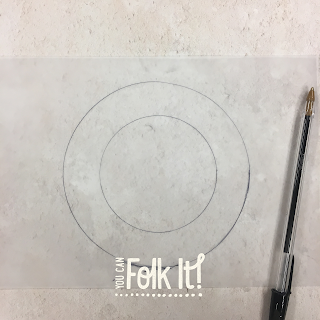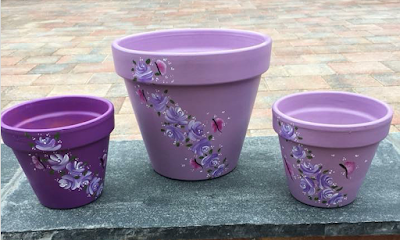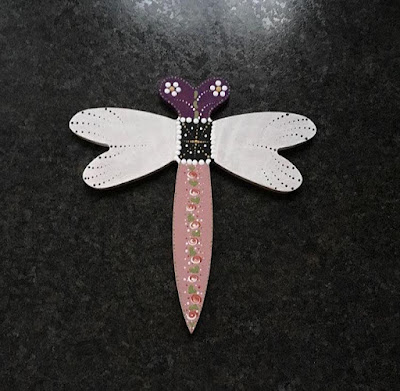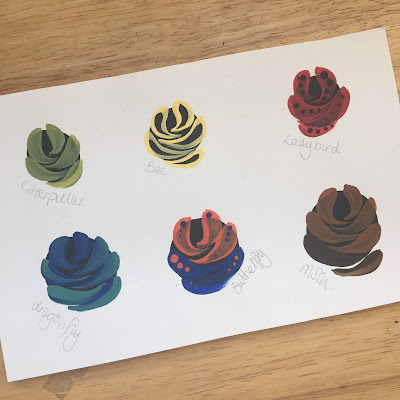So, the other day, we had a go at building a floral wreath, combining a few flowers and features to paint a full wreath. This week, we are going to look at a few other options to consider when you are designing your own unique pattern.
Option 1: The incomplete wreath
This option works with a circle but instead of wrapping your design around the whole circle, it consists of two halves. Here, we used our Oriental blossom which gave us an irregular shape but you could adapt this to use Rosebuds, daisies or a mix of flowers.
Step 1: Draw your circle lightly using a compass and pencil or by drawing round a circle using the chalk paper to transfer your markings.
Step 2: Imagine you cut your circle in half horizontally. Like last time, we are going to work closely to the circle but won't be afraid to detour slightly. Starting just above the half way line on the right hand side, draw your branch outline and finish at the opposite side. Add small branches on both sides of your line, again following the route of the circle. Next, leave a gap and draw a similar line from the left side round to the right. Now you should have two branches trailing the circle shape. Paint your branch using a shade of brown of your choice.
Step 3: Using the rule of 3 or 5, add your blossom flowers where you like. This will mean you will end up with 1 or 2 on the bottom branch and 2 or 3 blossom flowers on the top branch depending on how big your circle is and what you prefer.
Step 4: Finish your wreath by adding individual petals one by one. This is where you will need to keep taking a step back and seeing where your design looks too empty or where you need to even up your pattern.
Option 2: The Floral wreath
This wreath is quite tight and is perfect for those smaller flowers like rosebuds, lavender heads or dotty flowers.
Step 1: Begin by drawing a short line from your circle towards the inside of the circle, following the line of the circle. Next, about 1.5cm/2cm along the line, draw a line away from the circle. Continue to draw alternating lines around the whole circle.
Step 2: Using your liner brush, paint a line around the circle (but don't paint the stalks yet). Add a rosebud to the end of each line you have drawn (as you can see each rosebud follows the direction of the stalk).
Step 3: Fill in the gaps between each rose bud with s stroke leaves. As you can see, we could fit one leaf in most of the spaces in the inner ring and 1 or two leaves between the roses on the outer circle. Keep observing your wreath as you paint. The key to creating an eye catching wreath is to space out your elements and not squash too many things in to one space.
Step 4: Using your liner brush, paint stalks from the rosebuds and from each leaf to your original circle.
Step 5: Take a look at your wreath. Are there any areas that feel empty? We found a few and used the small end of our dotting tool to add three dots in places to complete the design and even up the wreath.
Option 3: The curved wreath
This is a great design for when you want to paint a limited number of elements such as lavender or foliage. If you haven't attended one of our painting workshops and aren't sure how to paint lavender, you can easily use our dotty lavender from the Flat Brush Starter kit
Step 1: Imagine you have used a curved line to divide your circle in to sections. Draw the last section of these lines across the circle, keep turning your page as you draw each one to make sure they flow in the same direction. You should end up with something like this (above). If you do not feel confident drawing out this template, pop over to our patterns board to use ours.
Step 2: Using your round brush or dotting tool, paint each lavender stalk using purple (we used Plum from our Flat Brush Starter kit and white). If, like we found, this created a nice wreath but left quite a bit of space in between the stalks, add extras in between to fill your wreath out nicely.
Step 3: Step back and take a look at your wreath. Are there any spaces? Using your liner brush and some green paint (we used Hauser light green) we added a few long comma strokes to fill some areas. We also used the small end of our dotting tool to again even up the circle.
We do hope you enjoy these patterns and ideas and if you do create a design after reading this post we would love to see it - just tag us or use #funwithfolkit to share.
Happy Folking x



























